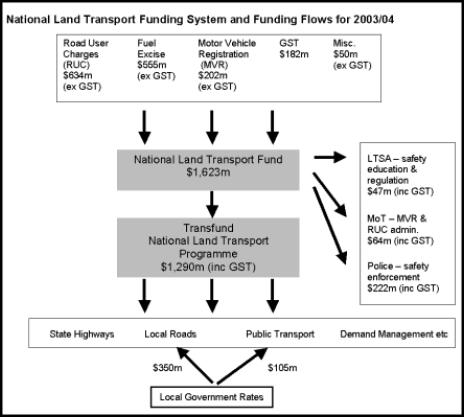Transport Fact Sheet 3 - Existing Funding System
The Existing Funding System
Transport Fact Sheet
Three
What is the National Land Transport Fund
(NLTF)?
The NLTF currently receives some $1.6 billion (including GST) of government funding for land transport. NLTF revenue comes primarily from a proportion of fuel excise on petrol, all road user charges (RUC) on vehicles and motor vehicle registration and licence fees1.
NLTF revenue is subject to short and long-term variation in funding revenue. Revenue to the NLTF fluctuates from year-to-year as a result of changes in national economic activity. In the longer-term, revenue is declining relative to kilometres travelled as vehicle fuel efficiency increases. Periodic adjustments in the level of fuel excise duty and RUC fees have been made to take account of these factors, inflation, and changes in government priorities.
How is NLTF revenue allocated?
NLTF revenue is firstly allocated to cover the costs of collection, management and administration of the fund system and refunds due in respect of excise RUC and licensing. The second call is for the Safety Administration Programme implemented by the Land Transport Safety Authority and New Zealand Police. The remaining funding is available to Transfund New Zealand for allocation under the National Land Transport Programme (NLTP).
National Land Transport Programme (NLTP)
Transfund New Zealand is responsible for developing and approving the NLTP, based on bids from approved public organisations. These organisations include territorial authorities, regional councils and Transit New Zealand. Funding must go to activities that effectively and efficiently contribute to a sustainable land transport system.
Transit New Zealand is responsible for managing the national highway system. Transit New Zealand is almost wholly funded from the NLTP.
Local government receives, on average, one dollar for every dollar they put toward projects which receive NLTP funding (known as the Financial Assistance Rate or FAR).
The Boards of Transfund New Zealand and Transit New Zealand are independent from the Minister and cannot be directed on individual projects. The government does, however, agree a statement of intent with each agency. In addition, each agency enters into an annual performance agreement with the Minister of Transport.
Government establishes the major divisions of expenditure (output classes) and Transfund develops the NLTP on that basis. There is also provision for general written directions, which must be tabled in Parliament. Through the use of written directions, performance agreements and the establishment of output classes, the government can define what it will purchase and the purpose of that purchase.
The NLTP consists of a list of approved and anticipated activities for the current year and 10-year forecasts of revenue and expenditure. Most of the funding in the programme is allocated to maintenance of roads and public transport services. Around $340 million a year is available for capital development of the land transport system, with about $133 million (excluding GST) of that spent on projects worth more than $3 million.
Projects may be at the scoping, investigation, design or construction stage. Major construction projects often extend over several construction seasons. Funds may be held in one year to fund construction projects in out-years.



 Gordon Campbell: On Why We Can’t Survive Two More Years Of This
Gordon Campbell: On Why We Can’t Survive Two More Years Of This NZTA: Forecast Strong Winds For Auckland Harbour Bridge Traffic
NZTA: Forecast Strong Winds For Auckland Harbour Bridge Traffic Queenstown Lakes District Council: Top 10 Most Hazardous Items Found In QLDC’s Waste Facilities And Rubbish And Recycling Bins In 2024
Queenstown Lakes District Council: Top 10 Most Hazardous Items Found In QLDC’s Waste Facilities And Rubbish And Recycling Bins In 2024 NZ Government: Drive Safely This Summer
NZ Government: Drive Safely This Summer Northland Inc: Game-Changing Investment For Northland - Resilience Fund Allocates $250,000 To Health Simulation & Training Centre
Northland Inc: Game-Changing Investment For Northland - Resilience Fund Allocates $250,000 To Health Simulation & Training Centre Interchurch Bioethics Council: Church Bioethics Agencies Express Dismay at the Rushed Consultation Period for Submissions on the Gene Technology Bill
Interchurch Bioethics Council: Church Bioethics Agencies Express Dismay at the Rushed Consultation Period for Submissions on the Gene Technology Bill New Zealand Police: More Than $2.5m Worth Of Assets Restrained In Undeclared Tobacco Case
New Zealand Police: More Than $2.5m Worth Of Assets Restrained In Undeclared Tobacco Case


